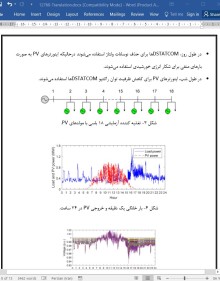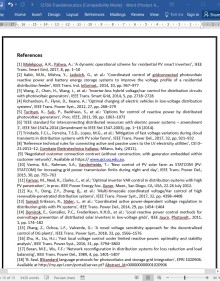
دانلود مقاله کاهش نوسانات ولتاژ با استفاده از DSTATCOM ها و توان راکتیو اینورترهای PV
چکیده
این مقاله کنترل توان راکتیو محلی برای کاهش نوسان ولتاژ در سیستم های ولتاژ متوسط با استفاده از DSTATCOMها و اینورترهای فتوولتائیک (PV) را ارائه می کند. حالت های جدیدی برای برآورد نوسانات ولتاژ و جبران های توان راکتیو توسط تبدیل متغیرهای جریان توان پاره خطی به تزریق های توان گره ای ایجاد می شوند. با استفاده از اندازه گیری های محلی و ولتاژها و انرژی خورشیدی، این روش می تواند یک برآورد سریع را از جبران-های توان راکتیو برای حفظ ولتاژ در هر باس فراهم کند. DSTATCOMها نیز به طور مناسب برای بهبود کنترل پذیری ولتاژ اختصاص داده می شوند. کنترل هماهنگ چندین منبع توان راکتیو نیز بررسی می شود. تابش خورشیدی یک ثانیه همراه با بارهای خانگی یک دقیقه برای نشان دادن کارایی روش پیشنهادی استفاده می شود.
1- مقدمه
افزایش استفاده از مولدهای PV در سیستم های توزیع موجب افزایش سریع نگران های درباره ایمنی ولتاژ شده است [1-3]. افزایش سریع ولتاژ ناشی از حرکات ابری سریع از چند ثانیه تا چند دقیقه در تغذیه کننده های توزیع درطول روز گزارش شده است. ضمنا، افت ولتاژ شدید ناشی از بارهای سنگین، شامل شارژ خانگی برای وسایل نقلیه الکتریکی در شب مشاهده شده است [4]. بنابراین، مخصوصا ایجاد یک راه حل جبران توان راکتیو موثر برای کاهش نوسان ولتاژ در شبکه توزیع ضروری می شود.
تنظیم کننده های ولتاژ و خازن های قابل تعویض به طور سنتی برای کاهش نوسانات ولتاژ آهسته ناشی از تغییرپذیری بار طراحی می شوند. از سوی دیگر، کنترل توان راکتیو آینده باید با نوسانات ولتاژ سریع و تصادفی ناشی از افزایش سرعت نفوذ PV سروکار داشته باشد [3،5]. مخصوصا، اینورترهای PVمی توانند یک پاسخ توان یک شیوه متوالی برای جلوگیری از جبران بیش از حد استفاده شدند. به طور مشابه، تاخیرات زمانی برای کنترل چندین منبع توان راکتیو در [3] اتخاذ شدند. اما، تاخیرات زمانی یک پاسخ همزمان به افزایش ولتاژ سریع شناسایی شده توسط دستگاه های توان راکتیو مختلف در تغذیه کننده یکسان را فراهم نمی کنند.
این مقاله کنترل توان راکتیو محلی سریع برای کاهش نوسان ولتاژ در سیستم های ولتاژ متوسط را ارائه می کند. حالت های جدیدی براساس تبدیل متغیرهای جریان توان پاره خطی به تزریق های توان گره ای برای برآورد نوسانات ولتاژ و جبران های توان راکتیو در محلی در هر باس ایجاد می شوند. یک الگوریتم تخصیص DSTATCOM سپس برای بهبود کنترل پذیری ولتاژ برای کل سیستم ارائه می شود. کنترل هماهنگ چندین منبع توان راکتیو، شامل DSTATCOMها و اینورترهای PV در این مقاله نیز بررسی می شود.
ترتیب بقیه مقاله به این صورت است: بخش 2 روش آن را ارائه می کند. بخش 3 نتایج به دست آمده در یک تغذیه کننده توزیع 18 باسی را نشان می دهد. درنهایت، نقش ها و نتیجه گیری این کار به طور خلاصه در بخش 4 توصیف می شوند.
4- نتیجه گیری
این مقاله کنترل توان راکتیو محلی سریع را برای کاهش نوسان ولتاژ ایجاد شده توسط تناوبی بودن انرژی خورشیدی در سیستم های توزیع مسکونی ارائه کرد. با استفاده از اندازه گیری های محلی ولتاژها و تزریق های انرژی خورشیدی، این روش می تواند یک برآورد سریع از نوسانات ولتاژ و جبران های توان راکتیو در هر باس را فراهم کند. یک الگوریتم تخصیص DSTATCOM برای بهبود کنترل پذیری ولتاژ برای کل سیستم ارائه شد. کنترل هماهنگ چندین منبع توان راکتیو برای کاهش نوسانات ولتاژ طی 24 ساعت بررسی شد. نتایج عددی تایید می-کنند که روش های کنترل محلی یک نتیجه مشابه به یک راه حل OPF را تولید می کنند که به اطلاعات شبکه کامل احتیاج دارد. در نظر گرفتن DSTATCOMها به صورت یک منبع مستقل در کنترل در طول روز منجر به یک بهبود قابل توجه در پروفیل های ولتاژ می شود و شکار انرژی خورشیدی را بیشینه می کند. ضمنا، کنترل هماهنگ چندین اینورتر PVسهم قابل توجهی در کاهش افت ولتاژ در طول شب دارد. با استفاده از داده های شبکه محلی محدود، روش پیشنهادی می تواند ابزار مناسبی برای کاربردهای همزمان (آنی) باشد.
Abstract
This paper proposes local reactive power control to mitigate the voltage fluctuation in medium-voltage systems using DSTATCOMs and photovoltaic (PV) inverters. New expressions are developed to estimate voltage fluctuations and reactive power compensations by transforming line segment power-flow variables into nodal power injections. Using local measurements of voltages and solar powers, the method can provide a fast estimation of reactive power compensations to maintain the voltage at every bus. DSTATCOMs are also properly allocated to enhance the voltage controllability. Coordinated control of multiple reactive power resources is investigated as well. One-second solar irradiance along with one-minute home loads is used to demonstrate the effectiveness of the proposed method.
1 Introduction
The growing participation of PV generators in distribution systems has raised immediate concerns about voltage security [1–3]. The rapid voltage rise due to fast cloud movements from a few seconds to minutes has been reported on distribution feeders during daytime. Meanwhile, the sharp voltage drop due to the contribution of heavy loads, including home charging for electric vehicles has been observed at night-time [4]. It, therefore, becomes particularly essential to develop an efficient reactive power compensation solution to mitigating the voltage fluctuation in the distribution grid.
Voltage regulators and switchable capacitors are traditionally designed to mitigate slow voltage fluctuations due to load variability. On the other hand, future reactive power control must deal with rapid and random voltage fluctuations due to the acceleration of PV penetration [3, 5]. Particularly, PV inverters can offer a fast reactive power response to eliminating such voltage fluctuations in addition to energy provision as the primary task under the standard IEEE 1547 in [6]. However, more costly oversized PV inverters are required and PV inverters to control reactive power can reduce the capability of solar energy harvest. This issue, therefore, might be one of the major challenges to motivate PV owners to support daytime voltage regulation in [7]. In addition, reactive power injections by PV inverters are not prevalently accepted by almost all utilities in [3] or possibly restricted by a 0.95 or 0.9 leading/lagging power factor capability [8, 9]. Further research into nighttime PV inverters operation are still necessary in [10]. Unlike PV inverters, distribution static synchronous compensators (DSTATCOMs) can be used as an independent reactive power source for voltage regulation. Hence, the current paper deploys DSTATCOMs to maintain the voltage while PV inverters are fully utilised to harvest solar energy during daytime. At night-time, PV inverters are used to reduce the capability of DSTATCOMs.
An enormous number of publications have developed control methods to address the voltage rise issue. Given full-network information, centralised reactive power control was formulated as an optimal power flow (OPF) solution to reduce system operational costs such as voltage deviations and power losses in [11, 12]. Voltage sensitivity analyses with respect to nodal power variations were made on the basis of a Jacobian matrix generated by Newton Raphson power-flows, as an efficient voltage control measure in [1, 2, 13, 14]. Yet, the sensitivities are necessarily updated according to the time-variability of loads and generation that requires full-network measurements as well in [15]. Similarly, variable power factor and active power sensitivity methods were introduced to control reactive power provided by PV farms in [7]. A gradient-projection method offered local voltage control to reduce the voltage fluctuation generated by fast cloud movements in [16], but ignored coordination among multiple reactive power facilities. In [15], a surface-fitting technique was adopted to capture voltage sensitivities according to variations of nodal active reactive power injections based on local-wind plants’ observability. This solution, nonetheless, was limited to single-plant control. Hence, time-delays were employed to take coordinated control actions of multiple plants in a sequential manner to prevent overcompensation. Similarly, time-delays were adopted to control multiple reactive power resources in [3]. However, time-delays would not provide a simultaneous response to the rapid voltage rise detected by various reactive power devices on the same feeder.
This paper presents fast local reactive power control to reduce the voltage fluctuation in medium-voltage systems. New expressions are developed based on transforming line segment power-flow variables into nodal power injections to estimate voltage fluctuations and local reactive power compensations at each bus. A DSTATCOM allocation algorithm is then presented to enhance the voltage controllability for the entire system. Coordinated control of multiple reactive power resources, including DSTATCOMs and PV inverters is investigated in the paper as well.
The rest of this paper is organised as follows: Section 2 presents its methodology. Section 3 shows results obtained on an 18-bus distribution feeder. Finally, the contributions and conclusion of the work are briefly described in Section 4.
4 Conclusion
This paper presented fast local reactive power control to mitigate the voltage fluctuation caused by the intermittency of solar power in residential distribution systems. Using local measurements of voltages and solar power injections, the method can provide a quick estimation of voltage fluctuations and reactive power compensations at each bus. A DSTATCOM allocation algorithm was introduced to enhance the voltage controllability for the entire system. Coordinated control of multiple reactive power resources was investigated to reduce voltage fluctuations over a 24-h day. Numerical results confirm that the local control method produces an outcome similar to an OPF solution that requires full-network information. Inclusion of DSTATCOMs as an independent source in daytime control leads to a significant improvement on voltage profiles while maximising solar energy harvest. Meanwhile, coordinated control of multiple PV inverters makes a significant contribution to reduced voltage drops at night-time. Using limited local-network data, the proposed method can be a useful tool for real-time applications.
چکیده
1- مقدمه
2- روش
2-1 پیش زمینه
2-1-1 مدل سیستم توزیع
2-2-1 کنترل محلی در مقابل متمرکز
2-2 کنترل توان راکتیو محلی پیشنهادی
2-2-1 تخصیص DSTATCOM
2-2-2 کنترل توان راکتیو هماهنگ
3- نتایج شبیه سازی
3-1 تخصیص DSTATCOM
3-2 کنترل توان راکتیو هماهنگ
4- نتیجه گیری
منابع
Abstract
1 Introduction
2 Methodology
2.1 Background
2.1.1 Distribution system model
2.1.2 Centralised versus local control
2.2 Proposed local reactive power control
2.2.1 DSTATCOM allocation
2.2.2 Coordinated reactive power control
3 Simulation results
3.1 DSTATCOM allocation
3.2 Coordinated reactive power control
4 Conclusion
References
- ترجمه فارسی مقاله با فرمت ورد (word) با قابلیت ویرایش، بدون آرم سایت ای ترجمه
- ترجمه فارسی مقاله با فرمت pdf، بدون آرم سایت ای ترجمه



